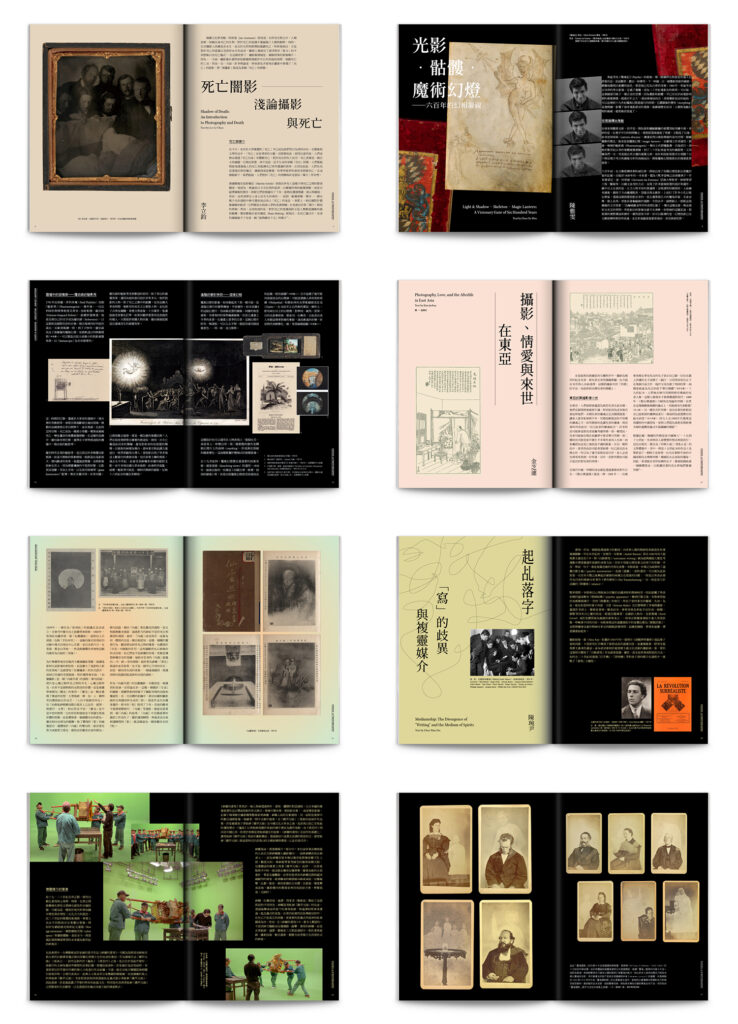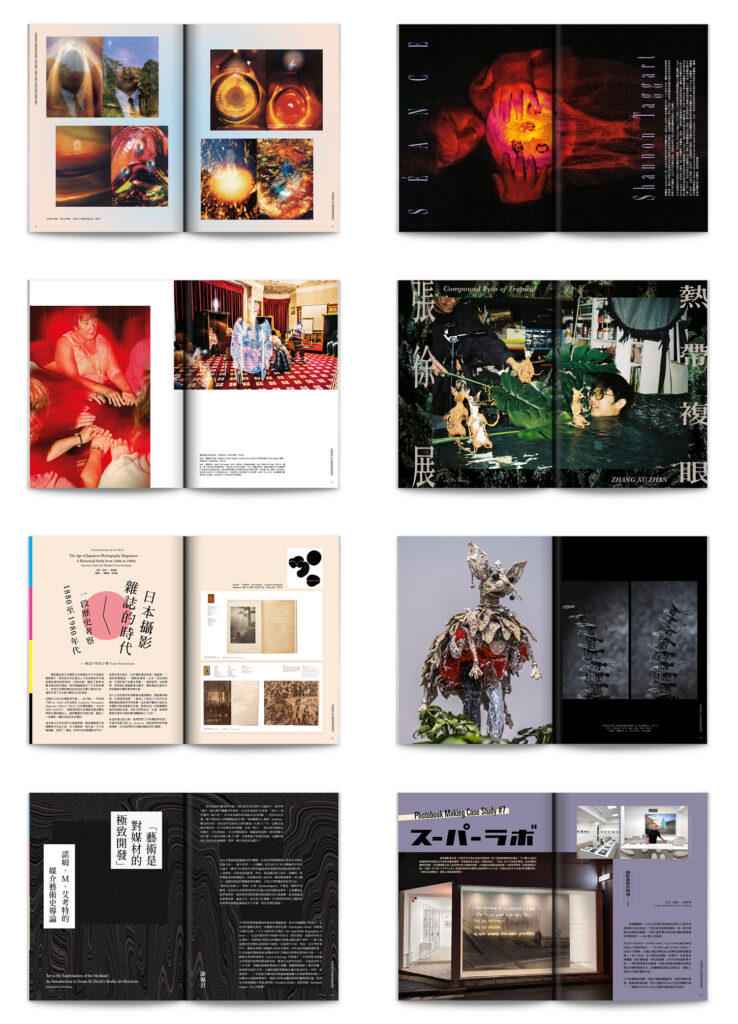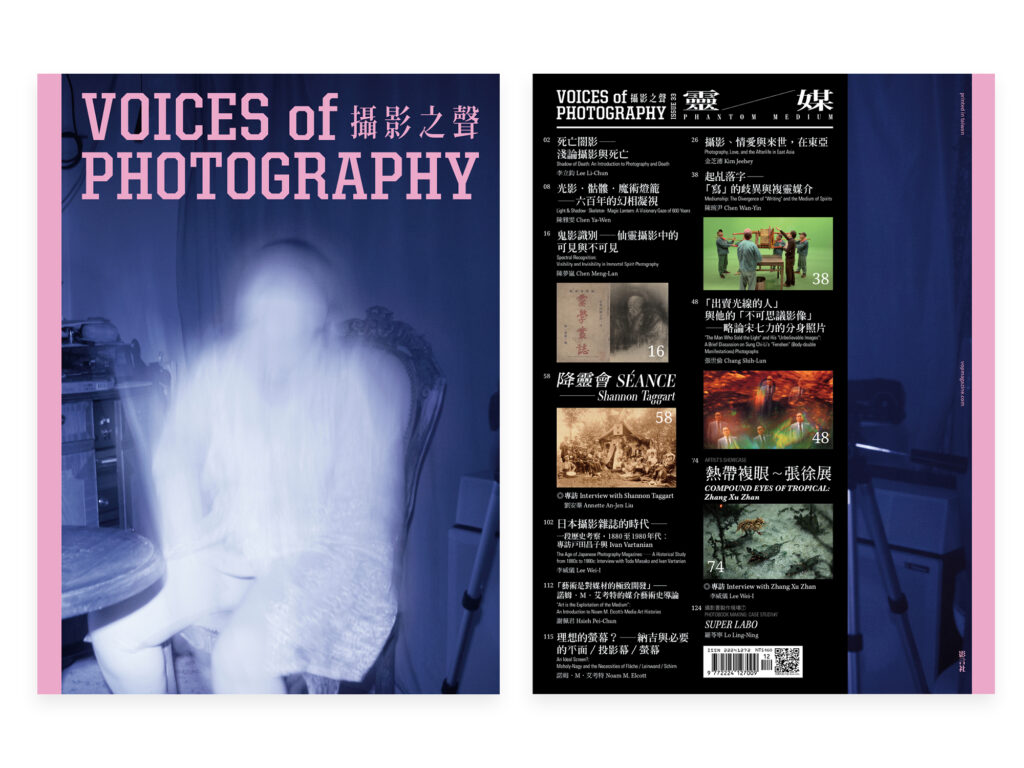攝影之聲 VOP Issue 33:靈/媒 Phantom Medium
出版地區:台灣
出版社:影言社
出版日期:2022/12
定價:460元
商品介紹
VOP Issue 33:靈/媒 Phantom Medium
攝影術到臨之初的首批照片──由法國攝影先驅伊波利特.巴雅爾(Hippolyte Bayard)於1840年代拍攝的《溺水者的自拍像》(Autoportrait en noyé),即預示了攝影與死亡論題的永恆交集,仿若宣告攝影成為牽亡與還魂、無有雙生的一種「冥介面」,迴盪於幽明之間。
在本期中,李立鈞闡述攝影何以成為肉身死亡的魂衣,卻又在十九世紀風行於世的死後肖像中傳遞永生。陳雅雯考掘過去六個世紀中,視覺主題裡古老卻不朽的骷髏之魄,如何巡遊於魔術幻燈、魅影秀,乃至化為電影時代的光影幻相。陳夢嵐尋究攝「影」裡「靈」的成相意指,探查1910年代民初時期在上海靈學團體間勃興的「仙靈攝影」,以及在嘗試捕捉「靈」的科學實證與精神欲念的往復之間所顯現的攝影本體論思索。在普遍相信「來世」並發展出相應傳統習俗的東亞,金芝潓對冥婚、遺照與殉情事件中的攝影,進行了跨地域的圖像文化史比較考察,同時揭示了亡靈牽引的影像背後的父權社會結構。陳琬尹對照受到二十世紀初「自動書寫」通靈術影響的歐陸前衛藝術、心靈科學檢測,以及藝術家許家維在其對馬祖當地神明「鐵甲元帥」神轎的起乩見諭與數位運算記錄共構的錄像作品,推究求索靈性與靈祇之媒介技術的種種流變。張世倫回顧自1990年代以來台灣最著名的靈學顯相案例──宋七力的分身攝影,剖視滿溢「光」與「像」的奇景宇宙,以及靈異影像在解嚴後的台灣社會一度形成流行現象的文化意涵。
此外,我們也特別介紹藝術家Shannon Taggart對唯靈論信仰展開長達近二十年的親身訪查,在《降靈會》系列中記錄了歷史悠久的歐美靈媒社群與當代通靈儀式,體現著同為靈「媒」的身體與攝影。「Artist’s Showcase」單元則特寫藝術家張徐展,介紹他近期倍受矚目的定格動畫《熱帶複眼》,探訪其轉化紙紮工藝、民俗藝陣與民間故事,所築塑出靈動的紙偶寓言劇場。而在層層幻幕中,本期由謝佩君譯介、首度揭載藝術史學者Noam M. Elcott對視覺媒介的關鍵要素「螢幕」的最新研究書寫,細緻考查了歐洲前衛派藝術家在二十世紀初對畫布到螢幕──從詞源到實踐、物質到象徵──的概念論說與實驗探索,他對媒材如何成為媒介的考論,為媒介史的探勘提供重要的思考觀點。
本期另聚焦日本的攝影出版文化,專訪攝影研究者戸田昌子與Ivan Vartanian,分享他們針對日本攝影雜誌史甫完成規模龐大的彙編著述,探尋自1880年代以降日本攝影刊物最為興盛的一百年間在日本攝影界與影像出版史留下的足印。「攝影書製作現場」系列則造訪獨立出版社SUPER LABO位於東京的專屬展示空間,細看此一別具特色的一人出版品牌的經營方法。

The very first set of photographs at the advent of photography, Autoportrait en noyé (Self Portrait as a Drowned Man), was taken by the French photographer and pioneer, Hippolyte Bayard in 1840. It is as though the photographs foreshadowed the eternal intersection of photography and the issue of death, declaring photography as a confluence of light and shadow that straddles between the visible and the unseen, through which the departed are evocated and resurrected.
In this issue, Lee Li-Chun describes how photography becomes the spirit that transcends the physical body, preaching the gospel of immortality through post-mortem photography that was most popular during the 19th century. Chen Ya-Wen explores the way the skeleton, the evergreen emblem in visual art, finds its way into magic lanterns and phantasmagoria to the light and shadow projections in films over the past six centuries. Chen Meng-Lan looks at the conceptual potential of the Chinese designation of photography, sheying, as “capturing shadows” and the discourse between the science and spirituality of photography as she looks at the works of the spiritualist group, Shanghai Lingxue Society, that was most active in ‘spirit photography’ during the early 1910s. In East Asia where most espouse a strong belief in the afterlife and practise relevant rituals to anticipate it, Kim Jeehey’s comparative research into the cultural imagery history across different regions through photographs taken of ‘ghost marriages’, death memorials and love-pact suicides reveals the patriarchal social structure behind the images that are driven by the dead. Chen Wan-Yin compares the European avant-garde movement of the early 20th century, spiritual science, and artist Hsu Chia-Wei’s video installation, using digital computing to depict the process of invocating the local deity of Matsu, Marshal Tie Jia. Chang Shih-Lun looks back at Taiwan’s most prominent cases of spiritual manifestations since the 1990s──Sung Chi-Li’s “fenshen” or body-double manifestation photographs──and examines the spectacle universe of “light” and “imagery”, and the cultural meaning behind the trend of spiritual photography that grew in Taiwan after the era of martial law.
cultural meaning behind the trend of spiritual photography that grew in Taiwan after the era of martial law.

In addition, we are also featuring artist Shannon Taggart’s work on spiritism that spanned over twenty years, culminating in her Séance series that documents spiritualist practices and communities in the United States and Europe, showcasing the body and photography as mediums. In “Artist’s Showcase”, we feature artist Zhang Xu Zhan and his recent stop-motion work Compound Eyes of Tropical that has attracted much attention. Through his work, we look at how he transformed the traditional art of papercraft, folk art and folklore into a lively paper puppet theater of fables. Meanwhile, amidst the many layers of illusion, we present art historian Noam. M. Elcott’s analysis on the significance of screens, a key element in the visual medium, for the first time ever. Translated by Hsieh Pei-Chun, we see Elcott’s study of the concept and practice of the European avant-garde artists in the early 20th century as they shifted from canvas to screens, from etymology to practice, and from materialism to symbolism. Elcott’s research on how the medium comes to be provides us with important points to think about as we look into the history of media.
This issue also shines the spotlight on the publishing scene in Japan with interviews with photography researchers Masako Toda and Ivan Vartanian, as they share their vast compilation of work on the history of Japanese photography magazines and the influence that they have left behind in the century since the 1880s when such publications saw their heyday. This new installment in the “Photobook Making Case Study” brings us to independent publisher SUPER LABO’s exclusive exhibition space in Tokyo, as we take a close look at the management style of this unique one-man publisher.

本期目錄 Contents
死亡闇影──淺論攝影與死亡
Shadow of Death: An Introduction to Photography and Death
李立鈞 Lee Li-Chun
光影.骷髏.魔術燈籠──六百年的幻相凝視
Light & Shadow. Skeleton. Magic Lantern:
A Visionary Gaze of 600 Years
陳雅雯 Chen Ya-Wen
鬼影識別──仙靈攝影中的可見與不可見
Spectral Recognition:
Visibility and Invisibility in Immortal Spirit Photography
陳夢嵐 Chen Meng-Lan
攝影、情愛與來世,在東亞
Photography, Love, and the Afterlife in East Asia
金芝潓 Kim Jeehey
起乩落字──「寫」的歧異與複靈媒介
Mediumship: The Divergence of “Writing” and the Medium of Spirits
陳琬尹 Chen Wan-Yin
「出賣光線的人」與他的「不可思議影像」──略論宋七力的分身照片
“The Man Who Sold the Light” and His “Unbelievable Images”:
A Brief Discussion on Sung Chi-Li’s “Fenshen” (Body-double Manifestations) Photographs
張世倫 Chang Shih-Lun
降靈會:Shannon Taggart
Séance: Shannon Taggart
專訪Shannon Taggart
Interview with Shannon Taggart
劉安蓁 Annette An-Jen Liu
Artist’s Showcase
熱帶複眼:張徐展
Compound Eyes of Tropical: Zhang Xu Zhan
專訪張徐展
Interview with Zhang Xu Zhan
李威儀 Lee Wei-I
日本攝影雜誌的時代──
一段歷史考察,1880至1980年代:專訪戸田昌子與Ivan Vartanian
The Age of Japanese Photography Magazines──
A Historical Study from 1880s to 1980s: Interview with Toda Masako and Ivan Vartanian
李威儀 Lee Wei-I
「藝術是對媒材的極致開發」──諾姆.M.艾考特的媒介藝術史導論
“Art is the Exploitation of the Medium”:
An Introduction to Noam M. Elcott’s Media Art Histories
謝佩君 Hsieh Pei-Chun
理想的螢幕?──納吉與必要的平面/投影幕/螢幕
An Ideal Screen?
Moholy-Nagy and the Necessities of Fläche / Leinwand / Schirm
諾姆.M.艾考特 Noam M. Elcott
攝影書製作現場系列7:SUPER LABO
Photobook Making Case Study #6: SUPER LABO
羅苓寧 Lo Ling-Ning













